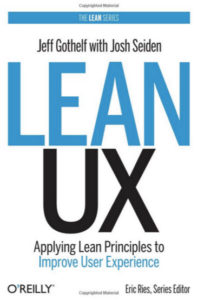Humility in development – a Lean UX concept
I was watching a presentation by Lean UX author, Jeff Gothelf, and a point he made about user-focused development – taking small steps, sensing and responding – really struck with me. So much so, I’ve written a bit of it up to share here.
In this presentation, Jeff Gothelf is talking at the 2015 Velocity Conference in New York to an audience of developers and software product managers.
But his message isn’t just for these groups. It’s for anyone managing any kind of digital service that is developing, changing and (ideally) improving.
So the concept here is equally valid for website managers developing content and evolving their sites.
Jeff talks about the need for humility. Accepting that we don’t know it all – in fact we don’t necessarily know very much – and planning our development to accommodate this. He’s saying we need to take small steps and at each stage find out how the work in progress is working out for business objectives and with target audiences.
Most importantly, not being afraid to say we were wrong and we need to change direction. That can be very difficult, and that’s where the humility comes in.
In a continuous world there is no end state to software. It’s this mythical state of perfection that we’re constantly pursuing.
Jeff Gothelf (@jboogie)
But most of all, Jeff’s analogy with the fog and the tree really hit home for me. It’s this part that I’ve transcribed below, but I would encourage you to watch the full 15 minute presentation.
Taking the position of humility
I’ve typed up a couple of minutes of what Jeff says while presenting this slide:
Drop into Jeff’s You Tube presentation at the point I’ve transcribed (9 min 24 sec)
“In a continuous world there is no end state to software. It’s this mythical state of perfection that we’re constantly pursuing.
As an organisation or as an individual, consider taking the position of humility. Between you and that mythical end state of the product that you’re working on, there is a fog.
And if you think about a fog, you can only see two or three steps into it.
A deliberate mindset says I’m just going to pick a direction and then go. Assume this is the right direction and hope I don’t fall off a cliff.
An emergent mindset says I think I should go in this direction, but I’m going to take two steps in that direction. A small deployment, an iteration, a sprint, whatever you want to call it. And when I get through those two steps I’m going to sense what’s changed around me. And then based on that new information I’m going to respond.
If the information says keep going -terrific -I’m going to keep going. But if the information says I shouldn’t continue down this path – there’s a cliff over there – then you have to change course.
And that’s by far the most difficult thing to do in any of these situations. As you’re collecting all this information, you’re getting ideas into market, new ideas are emerging, old ideas are getting invalidated, you have to be the one who raises their hand and says, “Listen! We shouldn’t go in this direction any more”.
And that’s very difficult.
But the interesting thing is that a position of humility creates agility. Because you’re never terribly confident of the direction that you’re heading in, it’s easier to change course.
This organisational agility drives organisational responsiveness.”
…a position of humility creates agility. Because you’re never terribly confident of the direction that you’re heading in, it’s easier to change course.
Jeff Gothelf (@jboogie)
Who is Jeff Gothelf?
Jeff wrote the book on Lean UX, called surprisingly enough, Lean UX.
I attended his ‘Lean UX in Enterprise’ day-long workshop last year, and have been putting his methods into practice ever since. Bruce also attended one of Jeff’s sessions a couple of years ago which encouraged us to use a collaborative sketching technique which has proved very useful when creating initial prototype designs.
Jeff is about to release a follow up book which I’m very much looking forward to. “Sense & Respond, How Successful Organizations Listen to Customers and Create New Products Continuously” is being released later in 2016 and (I believe) the target audience this time is more senior, with a focus on shaping organisations to enable Lean UX practices and a start-up mentality to thrive.
Sense and Respond – the book’s promotional website
What about the University of Edinburgh?
As software and website developers and managers at the University, do we sense and respond? Very rarely, if ever, I’d suggest. Certainly not on a continuous cycle.
We are beginning to work in a more collaborative and agile fashion, but I believe the driver is primarily to manage development time and resource more effectively. Of course we need to do that, but if we aren’t using agile development techniques as a means to better understand our customers’ needs and to deliver things that they want and need, we’re ultimately missing the point.
At the University Website Programme, we’re really embracing the Lean UX philosophy and employing it wherever we can in our projects: ranging from technical development, to user research to content development and website delivery.
A couple of examples from colleagues:
Rapid collaborative prototyping – blog post by Callum Kerr
Getting agile with content creation – blog post by Rachel Bhandari
Get help
If you’d like training for your team, or to just have sessions facilitated for you, get in touch with me to discuss how we can help.
A few of the areas we can support:
- Lean UX workshops to identify how and where your development effort is most likely to bring most benefit
- Prototyping training and collaborative sketching workshops to get your team and stakeholders sharing and ideas and testing requirements
- Usability testing training and agile usability workshops to get your team and stakeholders closer to end users, and prioritising the biggest issues
- Persona development training and facilitation to get your team and stakeholders focused on a commonly agreed set of users, their goals and needs




I think this is a really useful illustration of the problem.